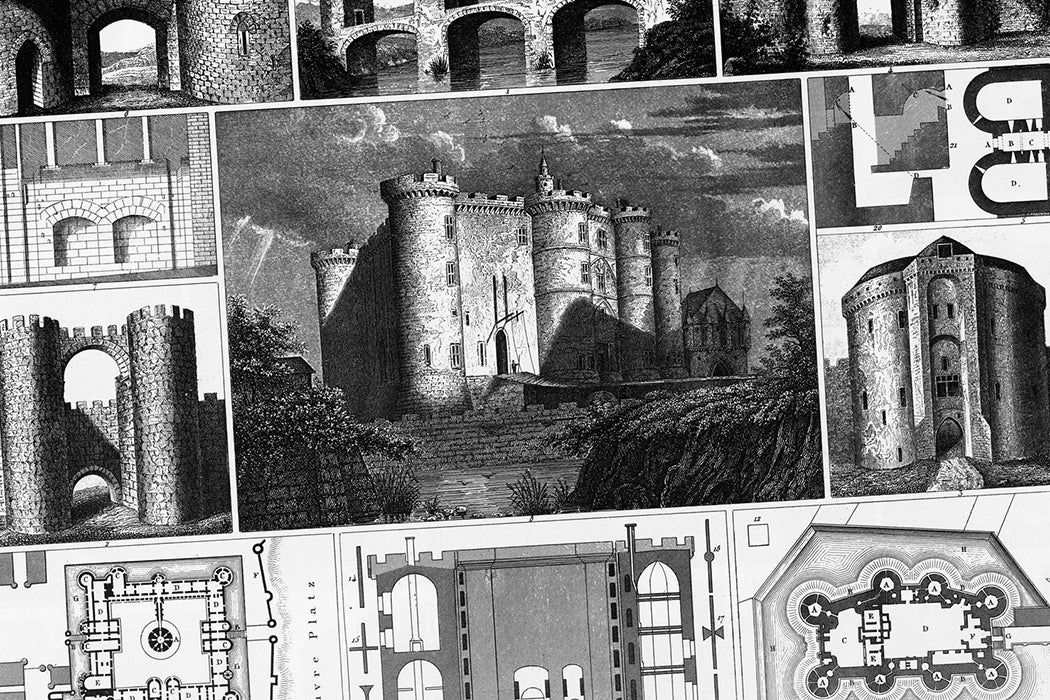The elite of medieval Europe were no strangers to elaborate entertainment. At their banquets, feast-laden tables floated from the ceilings, wine poured from fountains, and rosewater and sugared almonds pelted the guests’ heads like hail. By astounding and delighting their guests with seemingly magical feats, hosts demonstrated their wealth and power. At Hesdin, in France, the idyllic beauty of the grounds was counterpointed by the sadistic slapstick of the castle’s “engines of amusement,” prank machines that soaked guests with jets of water, spattered them with flour, and flung them into piles of feathers. Hesdin thus carried the performance of wealth and power to an unprecedented extreme.
Audio brought to you by curio.io
The project was begun under Count Robert II (1250–1302), perhaps inspired by his travels in the Mediterranean. It was continued and elaborated by his daughter, Mahaut of Artois, and later by Philip the Good. Over centuries, its amusements developed, and its fame spread.
Imagine you’re visiting the Chateau. You try to open a window, and it splashes you with water, then slams shut. You browse a book of ballads, and it flings soot at your face. You run to the mirror to see how all this dousing has affected your looks, and puff! You’re covered in flour. Nastiest of all was this trick: A statue cries out, ordering you to run to the next chamber in the name of the Count. If you obey, the huge automata in the next room beat you with sticks. There was also an assortment of pipes used “to wet the ladies from below.”
The visitors would emerge soaked, plastered from head to toe in flour and soot, with clothes, makeup, and hairdo ruined. Why did they come? Were they simply powerless to refuse the Count’s invitation? Or did they, on some level, delight in the shock and confusion, much as we delight in roller coasters and haunted houses?
Sadly, we can only guess. Hesdin was destroyed by war in 1553, and with it went the engines of amusement. We will never know precisely how they worked. Nor will we know exactly what motivated Count Robert to begin the project of their construction in the first place. He was unquestionably a little eccentric (for one, he let his pet wolf roam free, eating the nearby peasants’ livestock). But is that enough to explain Hesdin’s uniqueness? As historians, we have to make do with what we have—bills for the construction of the machines, maps of the complex, scant visitor’s accounts—to make sense of this oddity.
Zooming out to the castle’s wider surroundings can shed some light on its contents. Hesdin’s park fanned out from the castle in a thick wedge of meadows, woodlands, and marshes. Deer and hart grazed on its grassy slopes. The streams ran thick with carp and bream, and the meadows were dotted with strawberries. It was an aristocratic cornucopia, a land of plenty.
This appearance of natural wealth, however, was far from natural. Human hands sculpted the landscape, digging out ponds, erecting walls to pen in the wildlife (keeping out natural predators), and carving paths through the trees. It was a faux-wilderness, as much a work of artistry and technical ingenuity as any of the machines inside the castle.
Want more stories like this one?
Whimsical automata were scattered through these woodland paths. One bridge was watched over by a cadre of mechanical monkeys clad in badger skin to give them the appearance of life. The pavilion housed gilded, mechanical birds. These creatures spun an aura of the enchantment over the park, turning it into a kind of fairyland.
Count Robert II adored chivalric romances, which were packed with accounts of marvelous automata. The knight of a classic chivalric tale ventures into an unfamiliar, magic-suffused wilderness and returns transformed. In a sense, Hesdin was a reflection of these tales. Their preoccupations and even their narrative structure are mirrored in its layout.
The chamber of the Golden Fleece at Hesdin represents this idea in microcosmic form. Brilliant frescos covered the walls, illuminating each moment of the tale. A wooden statue of a hermit would recount to visitors how the mythical Greek hero Jason traveled through strange, treacherous lands in search of the Golden Fleece. Then, a flash and a crash of thunder. Rain and snow poured from the ceiling. It was as if the visitors were caught in the furious tempests that rocked Jason’s ship, entangled in the wonder and danger of the tale.
If the park of Hesdin was a chivalric romance, then perhaps the castle, with its engines of amusement, was a fabliau—Chaucer’s genre, which celebrates the coarse, the vulgar, and the buffoonish. By destroying their clothes and tricking them into humiliating situations, the castle’s devices stripped away the stiff exoskeleton of court propriety. Yet, as the chamber of the Golden Fleece implies, perhaps the delights of the garden and the humiliations of the castle are not as distinct as they seem. To take on the heroism of Jason, you must get soaked. Transformation demands torment, or at least discomfort, like a blitz of flour to the face.







